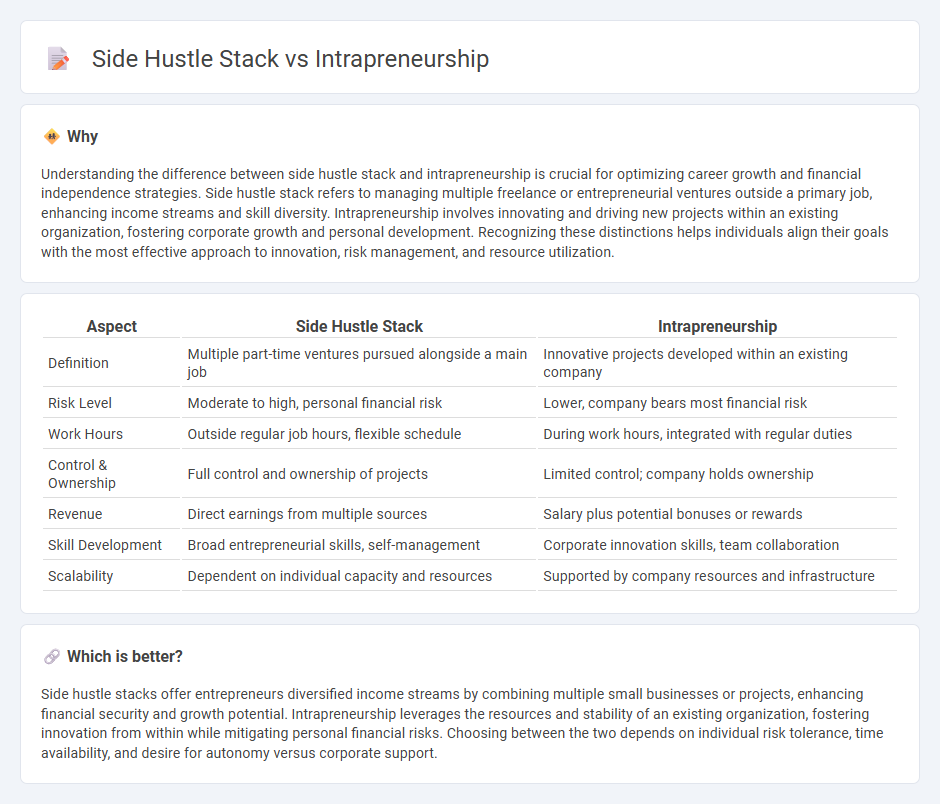
Side hustle stacks combine multiple income streams by leveraging skills and time outside a primary job, fostering financial independence and entrepreneurial experience. Intrapreneurship drives innovation within established companies by empowering employees to develop new products or processes while maintaining job security. Explore how balancing these paths can maximize your entrepreneurial success.
Why it is important
Understanding the difference between side hustle stack and intrapreneurship is crucial for optimizing career growth and financial independence strategies. Side hustle stack refers to managing multiple freelance or entrepreneurial ventures outside a primary job, enhancing income streams and skill diversity. Intrapreneurship involves innovating and driving new projects within an existing organization, fostering corporate growth and personal development. Recognizing these distinctions helps individuals align their goals with the most effective approach to innovation, risk management, and resource utilization.
Comparison Table
| Aspect | Side Hustle Stack | Intrapreneurship |
|---|---|---|
| Definition | Multiple part-time ventures pursued alongside a main job | Innovative projects developed within an existing company |
| Risk Level | Moderate to high, personal financial risk | Lower, company bears most financial risk |
| Work Hours | Outside regular job hours, flexible schedule | During work hours, integrated with regular duties |
| Control & Ownership | Full control and ownership of projects | Limited control; company holds ownership |
| Revenue | Direct earnings from multiple sources | Salary plus potential bonuses or rewards |
| Skill Development | Broad entrepreneurial skills, self-management | Corporate innovation skills, team collaboration |
| Scalability | Dependent on individual capacity and resources | Supported by company resources and infrastructure |
Which is better?
Side hustle stacks offer entrepreneurs diversified income streams by combining multiple small businesses or projects, enhancing financial security and growth potential. Intrapreneurship leverages the resources and stability of an existing organization, fostering innovation from within while mitigating personal financial risks. Choosing between the two depends on individual risk tolerance, time availability, and desire for autonomy versus corporate support.
Connection
Side hustle stacks empower individuals to leverage multiple income streams, complementing intrapreneurship by fostering entrepreneurial skills within existing organizations. Entrepreneurs engage in side hustles to experiment with ideas and build agility, which enhances their capacity for innovation and initiative in corporate settings. This synergy accelerates professional growth, driving both personal and organizational success through continuous value creation.
Key Terms
Innovation
Intrapreneurship drives innovation within established organizations by empowering employees to develop new ideas and drive growth while leveraging company resources. Side hustles foster entrepreneurial creativity independently, allowing individuals to experiment with innovative concepts outside their primary job roles. Explore how both approaches can fuel innovation effectively and find out which best suits your goals.
Autonomy
Intrapreneurship offers employees autonomy within a company, allowing them to innovate and manage projects with organizational support and resources. Side hustles provide complete independence but require managing all aspects of the venture personally, including risks and rewards. Explore detailed comparisons to determine which autonomy model aligns best with your career aspirations.
Resource Allocation
Intrapreneurship leverages company resources such as funding, expertise, and infrastructure, enabling employees to innovate within the organizational framework. Side hustles require personal resource allocation, including time, capital, and skills, often demanding a balance between primary employment and entrepreneurial activities. Explore deeper into how resource allocation impacts the success and scalability of intrapreneurship versus side hustles.
Source and External Links
What is intrapreneurship, and how can you cultivate it at your company? - Intrapreneurship refers to employees within established companies acting like entrepreneurs who innovate and improve their workplace by leveraging leadership, innovation, and adaptability without the financial risks of traditional entrepreneurship.
Intrapreneurship - Wikipedia - Intrapreneurship is behaving like an entrepreneur within a large organization, involving risk-taking and innovation to turn ideas into profitable products, with companies supporting such individuals through resources, distinct from entrepreneurs running independent ventures.
What is Intrapreneurship: Definition, Strategies, and Examples - Intrapreneurship is applying entrepreneurial principles inside companies, empowering employees to drive innovation using company resources to maintain competitiveness and adapt to markets by fostering a culture of agility and creativity.
 dowidth.com
dowidth.com